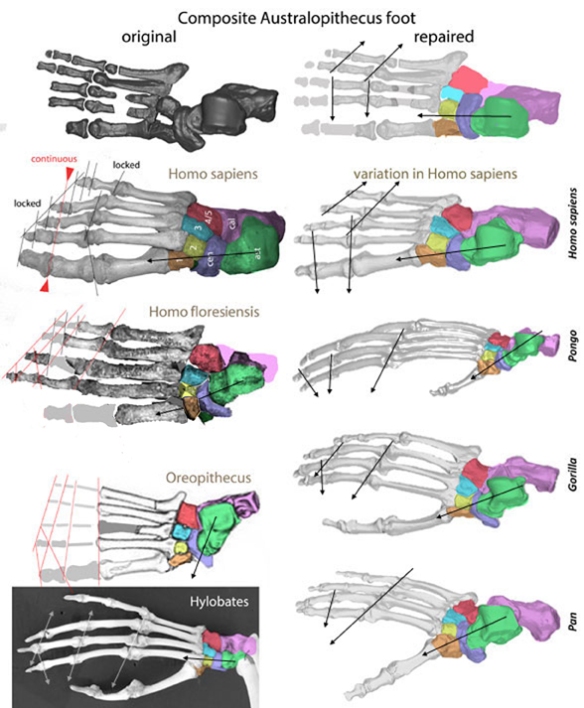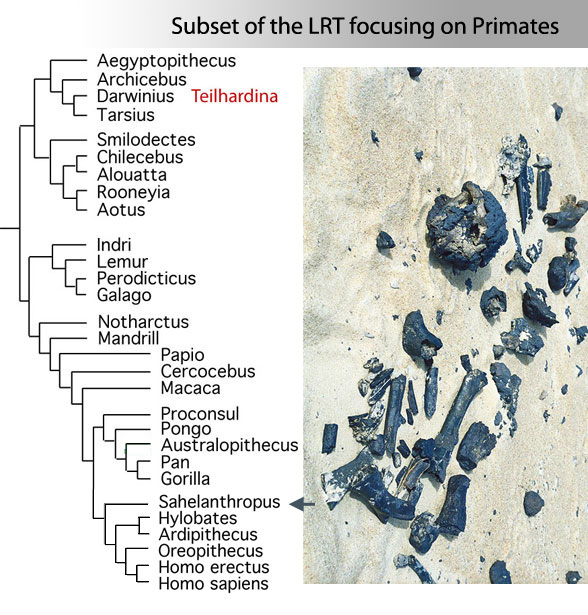Earlier we looked at several ape pedal (= foot) bones
in an effort to understand changes between terrestrial- and arboreal-adapted bauplans with the question: which one of these candidates is closest to humans?
Today this thread continues
with more included taxa, including a second, more gracile Homo sapiens (Fig 1 right column) example showing variation distinct from the original robust one (in the left column).
Some PILs
(parallel interphalangeal lines, Peters 2000a) are shown to assess their flexibility (with continuous PILs) or inflexibility (with discontinuous PILs).

Metatarsal 2 alignment
In the left column mt2 is deeper than mt3. In the right column it is not deeper than mt3 with the possible exception of Gorilla. Alignment permits flexion. Misalignment prevents flexion at the joint series. In all these apes mt2 is deeper than mt1.
Pedal digit 1 axial rotation
Most of the apes (Fig 1) have their ventral side in contact with the substrate. Hylobates and Gorilla are exceptions with digit 1 axially rotated with the ventral side oriented medially. The Homo pes in the left column also shows a bit of axial rotation, not duplicated in the Homo pes in the right column. More importantly, note in Pan and Gorilla, digits 2–4 are exposing their medial surfaces. That’s just another way of achieving the same morphology. In any case, this rotation contributes to a transverse arch in the sole of the foot, distinct from most tetrapods.
Tarsus variation
In most examples (Fig 1) the angle between the astragaulus (green) and centralia (lavender) has a medial vector extending to a medially directed digit 1. Hylobates and Homo have a more anteriorly directed vector running through digit 2.
Tarsus size
In most examples (Fig 1) the tarsus is relatively robust (>40% of the pedal length). In the arboreal Hylobates and Pongo the tarsus is much reduced relative to the digits and metatarsals.
First set of interphalangeal joints
In Pongo and Pan this first PIL extends beyond pedal digit 1. In Gorilla this PIL extends to pedal 2.2. In the other genera this PIL extends to pedal 2.1 or to the base of pedal 2.1 (the metatarsophalangeal joint).
At present
there is no complete Australopithecus foot. The composite shown here (Fig 1) is a best attempt, but it is a chimaera.

Not one of these traits, nor a dozen of these traits
will answer which of these taxa are closer to humans. To do that every trait from nose to toe must be considered. That’s what the large reptile tree (LRT, 2082 taxa, subset Fig 2) does. Even so it produces only a hypothesis of interrelationships, subject to change with the addition of new taxa and score corrections. Presently the gibbon lineage leads to humans. The traditional human ancestor, Australopithecus, nests with apes.
References
Brown P et al 2004. A new small-bodied hominin from the Late Pleistocene of Flores, Indonesia. Nature 431(7012): 1055–1061.
Gierlinski GD et al (8 co-authors) 2017. Possible hominin footprints from the late Miocene (c. 5.7 Ma) of Crete? Proceedings of the Geologists’ Associatiion 128(5–6):697–710.
Peters D 2000a. Description and Interpretation of Interphalangeal Lines in Tetrapods. Ichnos, 7: 11-41.
Peters D 2010. In defence of parallel interphalangeal lines. Historical Biology iFirst article, 2010, 1–6 DOI: 10.1080/08912961003663500
